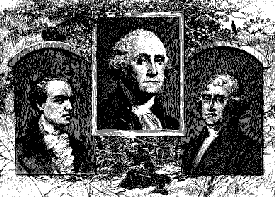

While the timeline of events about the fence issue described in the timeline provides the details of the events surrounding the spite fence, I would simply like to comment that I have been subjected to this kind of behavior on the part of the governing body of Barnesville since I moved here in January of 1989.
In both of the situations I have very briefly described below, I was unable to get any state entity to help me resolve the problems or deal with the misrepresentation on the part of the city of Barnesville.
The two situations described below illustrate that the problems with the governing body of the city of Barnesville over the spite-fence are not isolated incidents, but rather reflect a pattern.
I moved to Barnesville to restore a vacant, historic house, which was uninhabitable at the time. I lived in another vintage home while I worked to restore the historic home as well as the one I was living in.
When the building inspector told my contractor that the city wanted $400 per permit for each house I was working on, my contractor was appalled. He knew this was way out of line.
I asked at the Barnesville City Clerk to give me a copy of some sort of documentation describing the city's fees and the city's authority to issue building permits. In 1990, there had been little new construction for many years.
The city of Barnesville was unable or unwilling to provide me with any evidence that they had any statutory right to charge me a building permit fee, although they had been issuing building permits for adding patios or building garages.
At one point I tried to purchase a building permit and the City Clerk refused to sell me one.
Eventually the city of Barnesville filed charges against me for building without a permit. While the city governement had, even to the day of filing the charges, refused to give me a copy of the ordinance I had asked for, the city did have to provide some sort of ordinance to the court.
The ordinance, which I never saw until I received my copy of the charges the city had filed against me, clearly stated the city could charge me no more than $50 for a building permit. The city still went to pretrial insisting on $400, but agreed to settle for the $50 shortly before the case came to trail.
When the building inspector came by to collect the $50 for the permit, he tried to get me to pay the state's surcharge over and above the $50 that had been agreed upon between my attorney and the city's attorney.
The city's attorney called my attorney to report that I was not cooperating with the negotiated agreement when I would not pay more than the $50 stated in the letter of agreement.
After the June 1995 sheer wind storm that caused so much damage in this area, the city of Barnesville had to replace a power pole near the bank of Whiskey Creek.
In their paperwork to the Department of Natural Resources (DNR) about where they were working, they claimed they were installing the pole on the flat above the creek where the original pole had been. As a result, the DNR approved their application to replace the light pole without ever checking on what they were actually doing.
In reality, the city employees bulldozed the trees and bushes off the top edge of a roughly 70-degree incline which was over 15 feet high, tearing the upper creek bank apart. They then they hauled in several loads of fill dirt to try to lower the angle of the bank. This allowed them to install the replacement light pole in the center of this filled area halfway down the "remodeled" creek bank.
Two years later, during a wet spring, the fill dirt bank collapsed into the existing creek bed and blocked the course of the creek, forcing the water into a flood trace further upstream. This change in the course of the creek brought the creek closer to my house and caused me to lose about half an acre of land.
This forcing of the creek into the higher flood trace also created a deeper creek channel, impacting the depth of the creek upstream. This is one of the things the Army Corps of Engineers, which charges the DNR to oversee non-navigable waters, considers an unacceptable modification to wet lands. The DNR, having allowed this to happen, is uninterested in correcting or admitting or in any way interceding in the situation.
Obviously, the bank cannot be put back the way it was, but a culvert could be run under the collapsed bank to restore the creek to it's original course, or the city could compensate me for my lost land. The city contends they have done nothing wrong.
Diane Haugen
email: WhiskeyCreek@wcdd.com
Banana Republics in The Heartland
Essay on Minnesota's Banana Republics
Timeline of Events in Spite Fence Issue
Links Related to Civil and Individual Rights Issues
© Copyright 2001 Whiskey Creek Document Design. All Rights Reserved